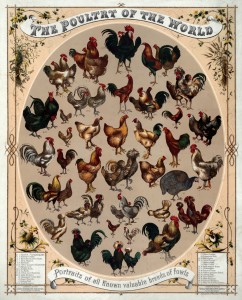I’d like to think Darwin might have had this poster, or something like it, in mind as he wrote the following words in the Domestication. But then he would have acknowledged it. He was meticulous about that.
As some naturalists may not be familiar with the chief breeds of the fowl, it will be advisable to give a condensed description of them. From what I have read and seen of specimens brought from several quarters of the world, I believe that most of the chief kinds have been imported into England, but many sub-breeds are probably still here unknown. The following discussion on the origin of the various breeds and on their characteristic differences does not pretend to completeness, but may be of some interest to the naturalist. The classification of the breeds cannot, as far as I can see, be made natural. They differ from each other in different degrees, and do not afford characters in subordination to each other, by which they can be ranked in group under group. They seem all to have diverged by independent and different roads from a single type.
The poultry of the world. Portraits of all known valuable breeds of fowl. Fifty-two types of identified chickens. Chromolithograph by L. Prang & Co., Boston, ca. 1868. From the Performing Arts Poster Collection at the U.S. Library of Congress. [PD] This picture is in the public domain. Downloaded from flickr.
